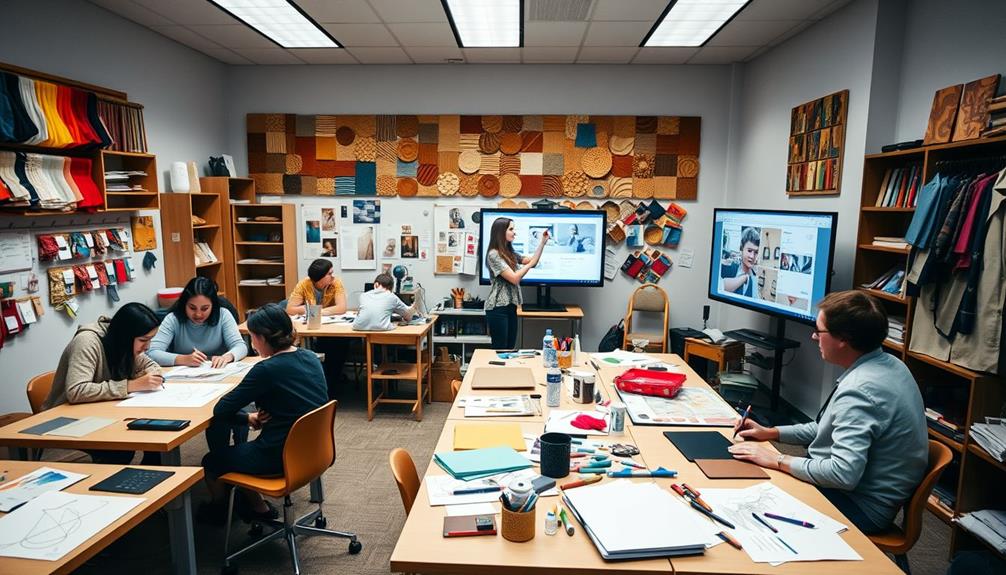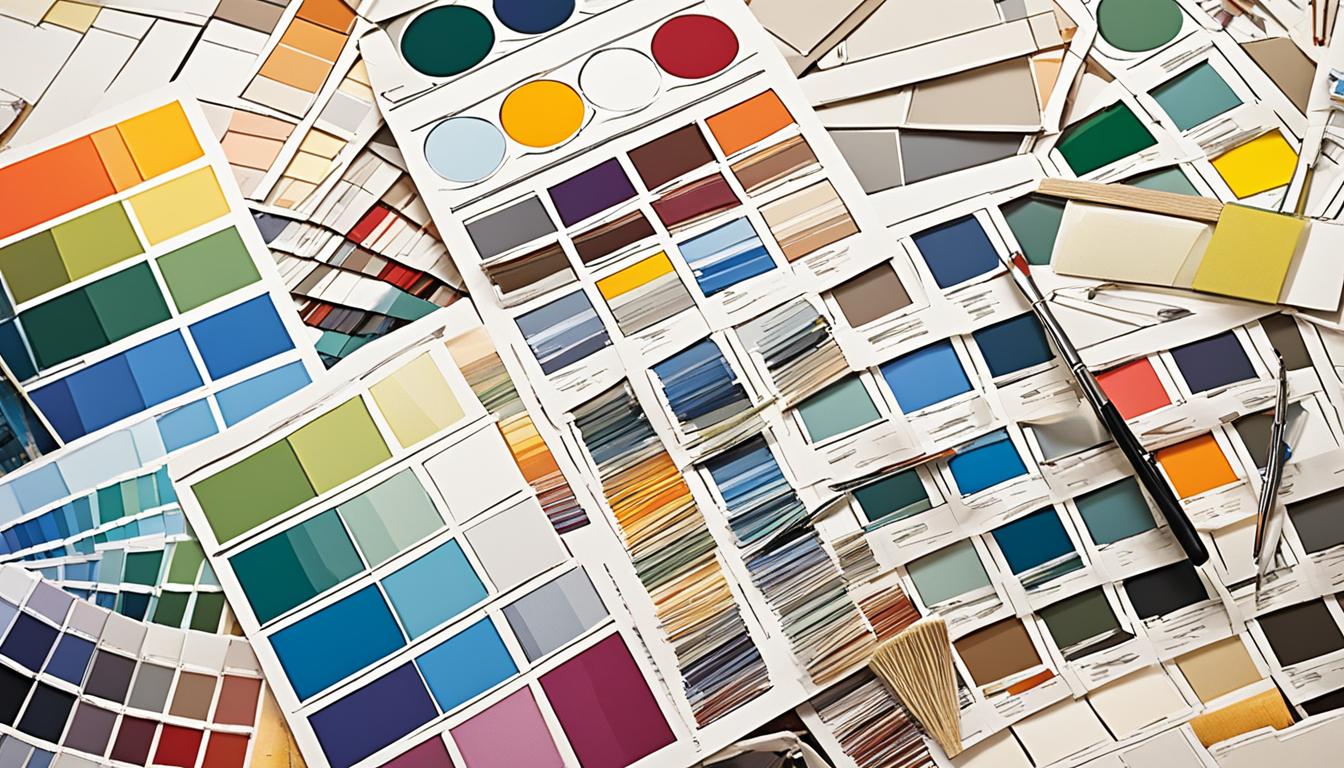To start an interior design course, you'll need to explore programs that offer a mix of creative and technical training, typically over 24 weeks. These courses often require about 4-6 hours of coursework each week and can be taken online for flexibility. Consider pursuing an associate's or bachelor's degree, and prepare for the NCIDQ exam to gain professional certification. Mastering CAD software is essential for design projects, and effective networking will help grow your career. By understanding industry trends, especially in sustainability, you'll set yourself apart. Stick around to uncover more about the journey ahead!
Key Takeaways
- Research accredited institutions offering online interior design courses to find a suitable program that fits your needs and goals.
- Enroll in a structured program that includes modules focusing on creative and technical skills development.
- Develop proficiency in essential tools like CAD software (AutoCAD, SketchUp, Revit) for effective design execution.
- Complete required coursework and prepare for the NCIDQ exam to gain professional certification and enhance your career prospects.
- Engage in networking opportunities through industry associations and events to build connections and support your professional growth.
Course Overview and Structure

The interior design course offers a detailed structure that includes 12 modules packed with assignments to help you develop both your creative flair and technical abilities over 24 weeks. In addition to the modules, you will have the opportunity to learn interior design software, such as AutoCAD and SketchUp, to enhance your technical skills. Throughout the course, you will receive personalized feedback from experienced interior designers to help you refine your skills and knowledge. By the end of the 24 weeks, you will have a comprehensive understanding of interior design principles and practical experience to jumpstart your career in the field.
This course of study is designed to nurture your skills in a balanced manner, blending technical knowledge, creative exploration, and essential business training. You'll engage with each module, dedicating about 4-6 hours per week to complete the coursework at your own pace.
Since the entire interior design program is delivered online, you can fit it into your existing commitments, making it easier to manage your time effectively. If you find yourself needing more time, you can even purchase extensions for added flexibility.
As you progress, you'll gain a recognized qualification that opens doors to a global community of design professionals.
This network provides invaluable opportunities for professional development and support, helping you to thrive in the competitive field of interior design. By the end of the course, you'll be well-prepared for various roles, equipped with a thorough understanding of both the creative and practical aspects of the industry.
Education and Certification Pathways

When considering your journey in interior design, understanding education and certification pathways is fundamental. You can start by pursuing an Associate's degree in Interior Design, which typically takes two years, or a Bachelor's degree, requiring four years of study. These programs provide a structured approach to essential topics like art history and color theory.
To become a professional interior designer, many states mandate formal education and the successful completion of the National Council for Interior Design Qualification (NCIDQ) exam. This exam consists of three parts: IDFX, IDPX, and practicum. Look for programs accredited by the Council for Interior Design Accreditation (CIDA), such as those offered by the University of Cincinnati or Cornell University, to guarantee quality education.
Additionally, obtaining professional certifications, like the Certified Residential Interior Designer from the Designer Society of America, can greatly enhance your career prospects and showcase your expertise.
Remember that continuous education units (CEUs) are essential for staying current in the industry and fulfilling licensing requirements. Engaging in seminars and workshops will help you stay updated on emerging trends and practices in interior design.
Skills Development and Technology

To excel in interior design, you'll need to master essential skills like drawing and perspective to communicate your ideas effectively.
You'll also want to get comfortable with technology, especially CAD software like AutoCAD and SketchUp, as these tools are vital for creating detailed designs.
Essential Design Skills
Mastering essential design skills sets you up for success in the interior design field. To thrive as a professional interior designer, you need to hone your organization, time management, and communication abilities. These skills are imperative for managing client relationships and project timelines effectively.
Proficiency in drawing and perspective is foundational, helping you visualize ideas and convey concepts clearly. Additionally, as you progress in your career in interior design, becoming familiar with CAD software like Autodesk AutoCAD, SketchUp, and Revit is increasingly expected. These tools streamline your design process and enhance your presentations.
Developing strong problem-solving skills is essential, too. You'll need to creatively address client needs and navigate project challenges. Staying updated on emerging technologies, including AI tools for ideation and layout suggestions, gives you a competitive edge in the industry.
Lastly, continuous skill development through workshops and advanced modules will enhance your portfolio and adaptability to changing market trends. By focusing on these essential design skills, you're not just preparing for your first job; you're laying the groundwork for a successful and evolving career in interior design.
Technology in Design
In today's fast-paced design world, technology plays a pivotal role in shaping how interior designers create and present their ideas. Mastery of CAD software like Autodesk AutoCAD, SketchUp, and Revit is fundamental for developing detailed design plans and 3D models. These tools not only help you visualize your design ideas but also enhance your critical thinking by allowing you to experiment and iterate quickly.
Additionally, incorporating advanced audio-visual elements, such as those found in a home theater setup, can elevate the presentation of your designs and provide immersive experiences for clients.
Familiarizing yourself with AI tools can further streamline your design process, providing layout suggestions that give you a competitive edge. To juggle multiple projects effectively, strong project management skills are essential. Being organized and managing your time well guarantees you meet client deadlines without compromising on quality.
Additionally, effective communication skills are imperative for clearly presenting your concepts to clients and stakeholders. The ability to convey your ideas persuasively can make a significant difference in your success.
Networking and Professional Growth

Networking is essential for your growth in interior design, as it opens doors to new career opportunities and collaborations.
By leveraging industry associations like ASID or IIDA, you can connect with professionals who can guide your journey.
Building these connections early on will enhance your visibility and help you establish a strong professional presence.
Building Professional Connections
While pursuing a career in interior design, building professional connections is essential for opening up job opportunities and fostering collaborations. Networking can lead to valuable relationships that enhance your visibility as a professional interior designer. Start by engaging with faculty and mentors from your online course, as their insights can guide your career path.
Consider joining professional associations like ASID and IIDA, which offer networking events and resources that aid in career advancement. Attend local trade shows and industry events; these venues not only help you learn about current trends but also connect you with fellow professionals.
Here's a quick overview of effective networking strategies:
| Strategy | Benefits | How to Implement |
|---|---|---|
| Join Professional Associations | Access to events and resources | Sign up for ASID or IIDA |
| Attend Trade Shows | Learn about trends and meet peers | Look for local events in your area |
| Utilize Online Platforms | Increase visibility and connect | Create a LinkedIn profile |
Leveraging Industry Associations
Leveraging industry associations can greatly enhance your career as an interior designer. Joining organizations like the American Society of Interior Designers (ASID) or the International Interior Design Association (IIDA) provides you with invaluable networking opportunities and resources essential for growth as a design professional.
- Access educational workshops and mentorship programs
- Participate in community projects with experienced interior designers
- Stay updated with certifications and continuing education units (CEUs)
- Attend trade shows to discover the latest design innovations
- Connect with job boards exclusive to members
By engaging with local chapters, you'll form connections that can lead to collaborations and job opportunities. These associations also offer paths to become a certified interior designer, which enhances your credentials and marketability.
The relationships you build can open doors to new projects and help you stay informed about industry trends. Investing time in these associations won't only improve your skills but also expand your professional network, positioning you for long-term success in the competitive field of interior design.
Your journey as a design professional can thrive through the support and resources these organizations provide.
Sustainability and Industry Trends

How can interior designers stay ahead in a rapidly evolving market? By embracing sustainability as a core principle in your interior design business.
Today's consumers are increasingly prioritizing eco-friendly materials and practices, making it essential for you as a professional interior designer to align your designs with these evolving preferences.
Pursuing certifications in sustainable design can set you apart in a competitive landscape, enhancing your design proposals and attracting eco-conscious clients.
Staying informed about sustainability initiatives, like LEED (Leadership in Energy and Environmental Design) standards, is vital for meeting industry demands and showcasing your commitment to responsible design.
Moreover, engaging in continuous education units (CEUs) can help you stay updated on the latest sustainability trends and fulfill professional requirements.
Implementing sustainable practices not only benefits the environment but also appeals to a growing segment of clients who value health and sustainability in their spaces.
Career Opportunities in Interior Design

With sustainability shaping the future of interior design, numerous career opportunities are emerging for those ready to make their mark in the industry.
The Greater Houston Area alone employs 1,637 interior designers, and with a job growth of 2.0% expected over the next four years, the demand for professionals remains stable.
Graduates can explore various paths, including:
- Working in design firms
- Project management roles
- Sales of materials and furnishings
- Independent consulting
- Teaching or mentoring future designers
The median wage for interior designers in the area stands at $27.57 per hour, translating to around $57,000 annually.
Plus, with about 75 job openings each year, you'll find ample opportunities to kickstart your career.
To boost your prospects, consider continuous professional development and networking with industry associations like ASID and IIDA.
By doing so, you'll enhance your skills and connections in the field, paving the way for growth and success as a professional interior designer.
Whether you're just starting or looking to advance, the opportunities in interior design are waiting for you.
Conclusion
In your journey through the world of interior design, you're not just learning to create spaces; you're weaving dreams into reality. Embrace every lesson as a brushstroke on your canvas, and let your creativity flow like a river. As you network and grow, remember that each connection is a stepping stone on your path to success. With sustainability at the forefront, you'll be crafting not just beautiful interiors, but a brighter future. So go ahead, transform your passion into a vibrant career!








